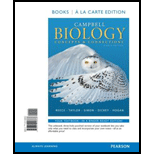
The possibility of extensive genetic testing raises questions about how personal genetic information should be used. For example, should employers or potential employers have access to such information? Why or why not? Should the information be available to insurance companies? Why or why not? Is there any reason for the government to keep genetic files? Is there any obligation to warn relatives who might share a defective gene? Might some people avoid being tested for fear of being labeled genetic outcasts? Or might they be compelled to be tested against their wishes? Can you think of other reasons to proceed with caution?
Want to see the full answer?
Check out a sample textbook solution
Chapter 12 Solutions
Campbell Biology: Concepts & Connections, Books a la Carte Plus Mastering Biology with eText -- Access Card Package (8th Edition)
- describe how electrofishing worksarrow_forwardwhen we collect fish or mussels we record a variety of biological information, including but not limited their sex, length, weight or a scale or finray or other tissue sample. Why do we do this, and what information are we hoping to obtain from these measurements and taking these samples?arrow_forwardDraw a rough sketch of the control and experimental data using a normal dose/response curve plot: i.e. % of total bound ligand vs. concentration. Indicate Kd and Bmax on this sketch. You don’t need to use exact numbers, but the relative proportions should be closearrow_forward
- Name something that could be happening to glutamate transporters that could have this effect on glutamate transport (i.e. the difference in glutamate transporters between control and experimental conditions). (Bonus: if you can also guess what the experimental condition is).arrow_forwarda. For the control condition, calculate Kd. Include units and show your work. b. For the control condition, calculate Bmax. Include units and show your work. c. For the experimental condition, calculate Kd. Include units and show your work. For the experimental condition, calculate Bmax. Include units and show your work.arrow_forwardNow draw a rough sketch of what the control data might look like if in addition to the specific binding, there was also a considerable amount of nonspecific binding (again using a normal dose/response curve)arrow_forward
- a. Which drug is the most potent? a,b,c,d,e b. Which drug has the highest efficacy?arrow_forwardThe shape of radishes may be long (SL/SL), oval (SL/SS), or round (SS/SS), and the color of radishes may be red (CR/CR), purple (CR/CW) or white (CW/CW). If a long, red radish plant is crossed with a round, white plant, what will be the appearance of the F1 and F2 generations?arrow_forwardNonearrow_forward
- Question #3: In the KeyGene paper, the authors state that it would be useful if pollen from an apomict would transmit apomixis-inducing genes to the female in the cross (assuming the pollen is viable). Assuming there was just one gene conferring gametophytic obligate apomixis, and that the two parents are inbreds, what would be the consequences of such a cross if: a) The apomixis was a dominant trait? Indicate the genotypes and phenotypes (apomict or non- apomict) of the parents, F1 and F2 generations. Remember to include the expected genotypic and phenotypic ratios (or percentages) in the F1 and F2 generations, and to position the female first (left side) in the parental cross. b) The apomixis was a recessive trait? Indicate the genotypes and phenotypes (apomict or non- apomict) of the parents, F1 and F2 generations. Remember to include the expected genotypic and phenotypic ratios (or percentages) in the F1 and F2 generations, and to position the female first (left side) in the…arrow_forwardQuestion #5: Assume that two genes are identified that confer gametophytic facultative apomixis in soybean. The genes show independent assortment. Recessive alleles at both loci are required for the facultative apomixis. Facultative apomixis is triggered when the temperature at pollination is above 20 degrees C. At temperatures below 20 degrees C, all reproduction is sexual, independent of genotype. A facultative apomict male, capable of producing viable pollen, was crossed with a sexually reproducing female. Assuming the parents are completely inbred, what are the predicted phenotypic ratios (apomict: non-apomict) for the F1, F2, and DH (F1-derived) generations at each of the following temperatures*: a) 15°C? b) 25°C? *for full credit, show crosses and genotypes where appropriate. Remember to position the female first (left side) in the cross. Type your answer here:arrow_forwarda. What percentage of a drug is eliminated after 4 half-lives? Please round to the nearest percent. b. What will happen to elimination of the drug in the previous question if the system is saturated? explain and show any math involvedarrow_forward
 Biology (MindTap Course List)BiologyISBN:9781337392938Author:Eldra Solomon, Charles Martin, Diana W. Martin, Linda R. BergPublisher:Cengage Learning
Biology (MindTap Course List)BiologyISBN:9781337392938Author:Eldra Solomon, Charles Martin, Diana W. Martin, Linda R. BergPublisher:Cengage Learning Human Heredity: Principles and Issues (MindTap Co...BiologyISBN:9781305251052Author:Michael CummingsPublisher:Cengage Learning
Human Heredity: Principles and Issues (MindTap Co...BiologyISBN:9781305251052Author:Michael CummingsPublisher:Cengage Learning Biology Today and Tomorrow without Physiology (Mi...BiologyISBN:9781305117396Author:Cecie Starr, Christine Evers, Lisa StarrPublisher:Cengage Learning
Biology Today and Tomorrow without Physiology (Mi...BiologyISBN:9781305117396Author:Cecie Starr, Christine Evers, Lisa StarrPublisher:Cengage Learning Human Biology (MindTap Course List)BiologyISBN:9781305112100Author:Cecie Starr, Beverly McMillanPublisher:Cengage Learning
Human Biology (MindTap Course List)BiologyISBN:9781305112100Author:Cecie Starr, Beverly McMillanPublisher:Cengage Learning Understanding Nutrition (MindTap Course List)Health & NutritionISBN:9781337392693Author:Eleanor Noss Whitney, Sharon Rady RolfesPublisher:Cengage Learning
Understanding Nutrition (MindTap Course List)Health & NutritionISBN:9781337392693Author:Eleanor Noss Whitney, Sharon Rady RolfesPublisher:Cengage Learning





